A Guide to Software Development Cost Estimation
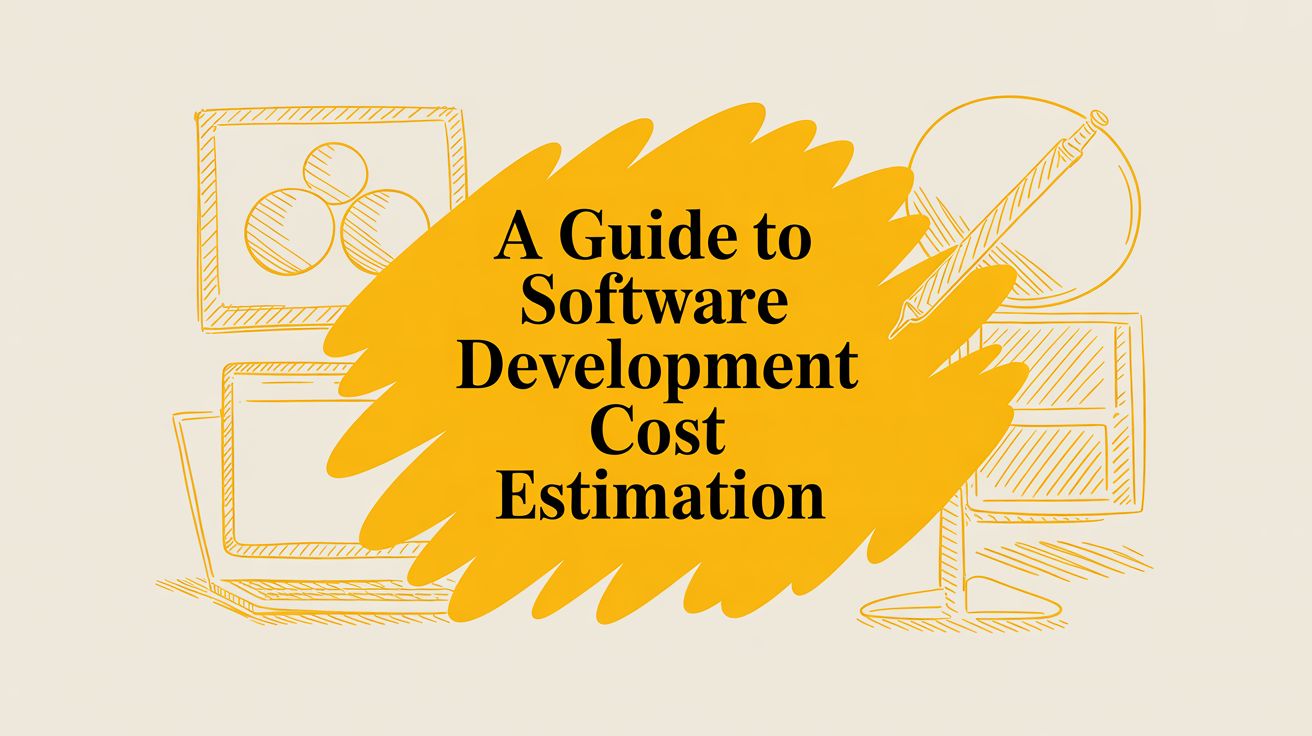
Trying to estimate the cost of a software project can feel like a guessing game. It’s complicated, riddled with variables, and almost never 100% on the money. The final price tag is a moving target, influenced by everything from feature complexity to where your development team is based. That’s why a solid estimation process isn’t just nice to have—it's essential for project success and keeping your budget in check.
Why Software Cost Estimation Is So Deceptive
Have you ever asked, "How much will my software cost?" and gotten a frustratingly vague "it depends"? That’s not a dodge; it's an honest reflection of how intricate building a digital product really is.
Think of it like building a house. Asking for a software price without providing any details is like asking for the cost of a house without specifying whether you want a tiny cabin or a sprawling mansion.
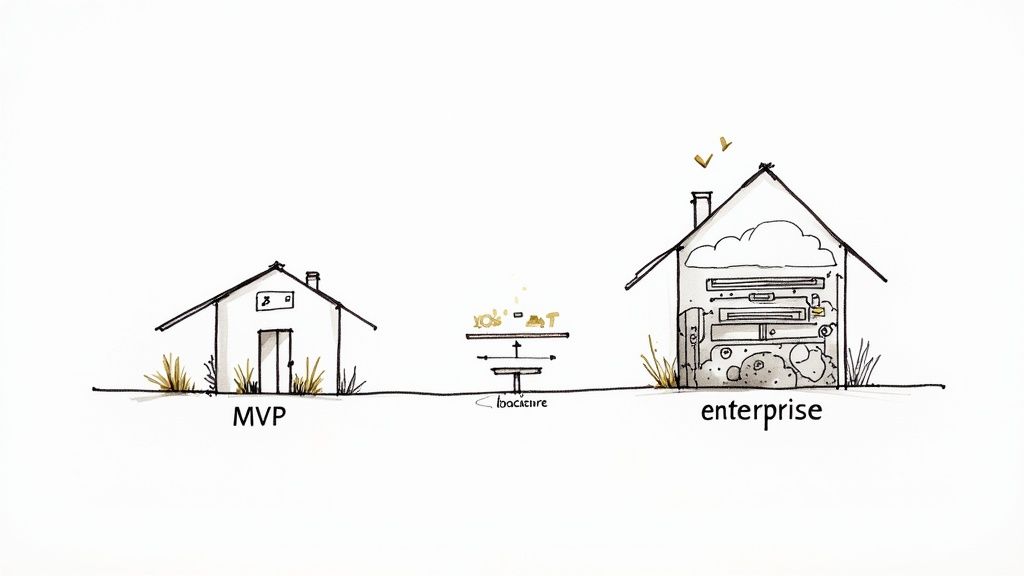
The final number really boils down to a few core variables that every project shares.
- Scope: This is the "what" of your project. Are you building a simple landing page, or a complex e-commerce platform with a dozen integrations?
- Complexity: This is the "how." Does your project need custom algorithms, real-time data processing, or high-level security measures?
- Technology: The tools matter. Using open-source libraries is a completely different financial picture than licensing expensive enterprise software.
Getting a handle on these components is the first step to making sense of the whole process. It turns that vague "it depends" into a structured conversation about features, effort, and resources. This clarity is why a formal estimation process isn't just red tape; it’s the bedrock of a successful, on-budget project.
Understanding The Financial Landscape
To get a feel for what’s realistic, it helps to look at typical market rates. In 2025, software development costs can range anywhere from $50,000 for simple projects to over $1,000,000 for massive enterprise applications.
What’s really telling is that about 63% of the total budget usually goes directly to the development phase. That's where the bulk of the investment lies. You can find more insights on software development pricing to help you prepare your budget.
A well-defined estimation process does more than just predict costs. It aligns stakeholders, clarifies objectives, and creates a roadmap that prevents scope creep and budget overruns before a single line of code is written.
To give you a clearer picture, here’s a quick breakdown of how complexity tends to influence the budget.
Software Project Cost Ranges by Complexity
| Project Complexity | Typical Cost Range |
|---|---|
| Simple (e.g., MVP, basic brochure site) | $30,000 – $100,000 |
| Medium (e.g., custom features, API integrations) | $80,000 – $200,000 |
| Highly Complex (e.g., enterprise systems, AI/ML) | $100,000 – $300,000+ |
As you can see, the jump is significant as you add more sophisticated features and requirements.
Ultimately, a realistic software development cost estimation is less about finding a magic number and more about understanding the journey. It requires breaking a big vision down into manageable pieces, assigning value to each one, and planning for the unexpected. With that mindset, you can approach your next project with confidence.
The Hidden Factors Driving Your Project Budget
The final number on any project estimate is influenced by a lot more than just the obvious stuff. It’s easy to get fixated on big-ticket items, but a really solid cost estimation digs into the hidden factors that can sneak up and inflate your budget. These things go way beyond just counting features and developer hours.
Think of your project scope as the architectural blueprint for your software. A simple blueprint for a small cabin is one thing; a detailed plan for a skyscraper is another entirely. A vague or poorly defined scope is the number one reason costs spiral out of control, because that ambiguity always leads to expensive rework and "oh, we forgot to add this" moments. If you want to get this part right, our guide on how to define project scope is a great place to start: https://getnerdify.com/blog/how-to-define-project-scope.
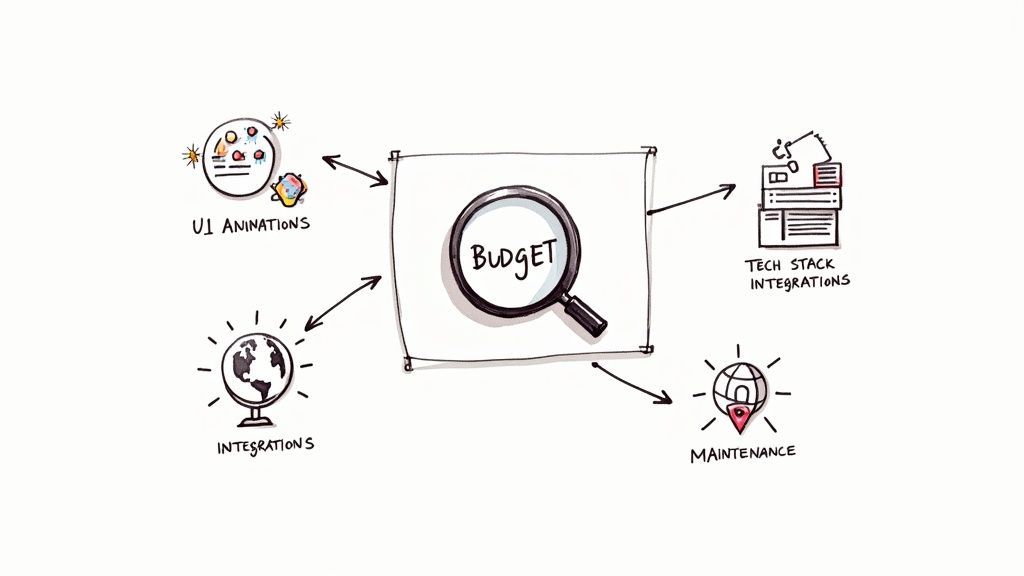
Design and User Experience Complexity
How your software looks and feels has a massive impact on the price tag. A clean, simple UI built from a standard template is always going to be more budget-friendly than a completely custom-designed interface with bespoke animations and complex user flows.
Great user experience (UX) isn't just about making things pretty. It’s a whole process involving research, prototyping, and user testing to make sure the final product is intuitive and genuinely enjoyable to use. This work requires specialists and adds significant time to the project, which directly bumps up the cost. The more polished and unique you want that user journey to be, the bigger the budget slice you'll need for UX/UI design.
Your Technology Stack and Integrations
The specific tools and platforms you choose to build on are another major cost driver. Opting for open-source technologies versus licensed enterprise software can create a huge gap in your expenses. For instance, using a free database like PostgreSQL has a very different financial impact than licensing a high-performance proprietary one from a vendor.
On top of that, modern software rarely lives in a bubble. It almost always needs to talk to other systems.
- Third-Party APIs: Do you need to connect to a payment gateway like Stripe, a mapping service like Google Maps, or social media platforms? Each integration takes development work and often comes with its own subscription fees.
- Custom Integrations: If you need to connect to an old-school legacy system or some other proprietary software, things can get complicated—and expensive—fast. This often requires highly specialized expertise.
Every single integration adds another layer of complexity, testing, and potential cost.
Every feature, design choice, and technical decision is a financial decision. A realistic budget accounts for not only the visible development work but also the hidden costs of integration, licensing, and long-term maintenance.
Team Composition and Geographic Location
Who builds your software and where they’re located are two of the biggest levers on your budget. The makeup of your team is critical. A project that needs senior architects and specialized data scientists is going to have a much higher price than one that can be handled by a team of more junior developers.
Location is the other huge variable. Developer rates in North America or Western Europe can easily be two to three times higher than rates for developers with the exact same skills in Eastern Europe or Latin America. This is why so many companies look at nearshore or offshore partnerships as a way to control costs without compromising on quality. To get a better sense of where the money goes, it helps to start unpacking the various costs of software development.
Finally, don’t fall into the trap of forgetting about post-launch costs. The work isn't over when the software goes live. You've got to plan for ongoing maintenance, bug fixes, server hosting, and security updates. These aren't one-time expenses; they are a crucial part of the software's total cost of ownership over its lifetime.
Choosing Your Software Estimation Model
Once you've got a handle on the factors driving your budget, it's time to actually run the numbers. But how? This is where software estimation models come in.
Think of these models as different tools in a toolbox. You wouldn't use a sledgehammer to hang a picture frame, right? Likewise, the tool you choose for estimation depends entirely on the job at hand. A quick, high-level forecast for a stakeholder meeting calls for a different approach than a detailed breakdown for your team's next two-week sprint. The trick is picking the model that gives you the right level of precision for your specific need.
From Traditional to Agile Estimation
In the old days of waterfall development, when projects were planned out in minute detail from the start, methods like the Constructive Cost Model (COCOMO) were king. These models are heavy on complex formulas and historical data, often trying to predict effort based on things like the total number of lines of code. While groundbreaking in their time, they can feel a bit rigid and clunky for the way most software is built today.
Modern development is all about agility and adapting to change. This shift brought a new wave of estimation techniques that embrace uncertainty. Instead of chasing perfect, down-to-the-minute predictions, these Agile methods focus on relative effort and collaboration, which is a much more realistic way to approach complex software projects.
Story Points: It's About Effort, Not Hours
One of the most common and powerful Agile techniques is Story Points. This is a fundamental shift in thinking. The team stops asking, "How many hours will this take?" and starts asking, "How big is this task compared to other tasks?" It's a simple change, but it makes a world of difference by separating the work's complexity from the time it takes any single person to complete it.
Imagine you’re helping a friend move. You see a small box of books, a medium box of dishes, and a huge box full of winter coats. You don't know if it will take 10 minutes or 30 minutes to move each one, but you know instantly which one is the most effort. That's the core idea.
Teams often use a modified Fibonacci sequence (1, 2, 3, 5, 8, 13...) to assign points. The growing gaps between numbers reflect the increasing uncertainty that comes with larger tasks. A simple text change might be a 1, adding a new field to a form could be a 3, and integrating with a third-party payment gateway might be an 8 or 13.
The goal of Story Points isn't to predict the exact delivery date of a single feature. It's about creating a reliable forecast of how much work a team can complete over time, which is far more valuable for long-term planning.
T-Shirt Sizing: A Quick Relative Gauge
What if you're in the very early stages of planning and just need a rough idea of scale? This is the perfect time for T-Shirt Sizing. It’s as simple as it sounds: you group features or project ideas into sizes like XS, S, M, L, and XL.
This is a fantastic tool for building an initial product roadmap because it keeps the conversation high-level. It helps everyone in the room quickly grasp the relative size of different initiatives without getting bogged down in debates over specific numbers.
- XS: A tiny tweak, like changing a button color.
- S: A small, well-defined task.
- M: A standard, multi-step feature.
- L: A large, complex feature that involves multiple parts of the system.
- XL: A massive effort (an "epic") that definitely needs to be broken down into smaller pieces.
By focusing on general size, teams can prioritize more effectively. For a deeper dive, you can explore many more software estimation techniques that teams use to refine their forecasts.
Comparison of Estimation Techniques
To help you choose the right approach, here's a quick breakdown of these popular techniques. Each one has its place, and many teams use a combination of them depending on the situation.
| Technique | Core Principle | Best For | Pros | Cons |
|---|---|---|---|---|
| COCOMO | Algorithmic model based on historical data and lines of code. | Large, traditional waterfall projects with well-defined requirements. | Provides a repeatable, data-driven estimate. | Inflexible; not suited for Agile projects or changing requirements. |
| Story Points | Measures relative effort, complexity, and uncertainty. | Agile teams doing iterative development (sprints). | Separates effort from time; fosters team consensus; improves velocity tracking. | Can be abstract for new teams or external stakeholders. |
| T-Shirt Sizing | Groups work into intuitive size categories (XS, S, M, L, XL). | High-level roadmap planning and initial project scoping. | Very fast and easy to understand; avoids premature precision. | Too vague for detailed sprint planning; not a precise measure. |
| Planning Poker | A consensus-based game to assign Story Points. | Agile teams that need to estimate a backlog of user stories. | Collaborative; uncovers hidden assumptions and risks; highly engaging. | Can be time-consuming for large backlogs; requires full team participation. |
Ultimately, the best technique is the one your team understands, agrees upon, and can apply consistently.
Planning Poker: Making Estimation a Team Sport
So, how does a team actually agree on a Story Point value or T-shirt size? One of the best ways is through a collaborative exercise called Planning Poker. It’s less of a game and more of a structured conversation that harnesses the entire team's collective brainpower.
Here’s the play-by-play:
- The Task is Presented: The product owner walks the team through a user story, explaining the "what" and the "why."
- Team Members Discuss: The engineers, designers, and testers fire off questions to make sure everyone is on the same page about the scope of the work.
- Everyone Votes: Each person privately selects a card with a number (representing their estimate) and keeps it hidden.
- Cards are Revealed: On the count of three, everyone shows their card at the same time.
If the estimates are all in the same ballpark, fantastic—the team locks it in and moves on. But the real magic happens when the numbers are wildly different. If one developer holds up a 3 and another holds up a 13, it immediately triggers a crucial discussion. The person with the high estimate might know about a tricky dependency the others overlooked, while the person with the low estimate might see a shortcut. This process ensures the final estimate is a true reflection of the team's shared knowledge.
Your Step-by-Step Project Estimation Framework
Knowing the theory behind cost estimation is great, but the real test is applying it in the wild. A solid, defensible software cost estimate isn’t pulled out of thin air or from a single calculation. It’s the result of a structured, repeatable process.
Think of this framework as your financial roadmap. You wouldn't start a cross-country road trip without a map, and you shouldn't start a project without a clear budget plan. Each step here adds another layer of detail, systematically chipping away at uncertainty and getting your entire team on the same page.
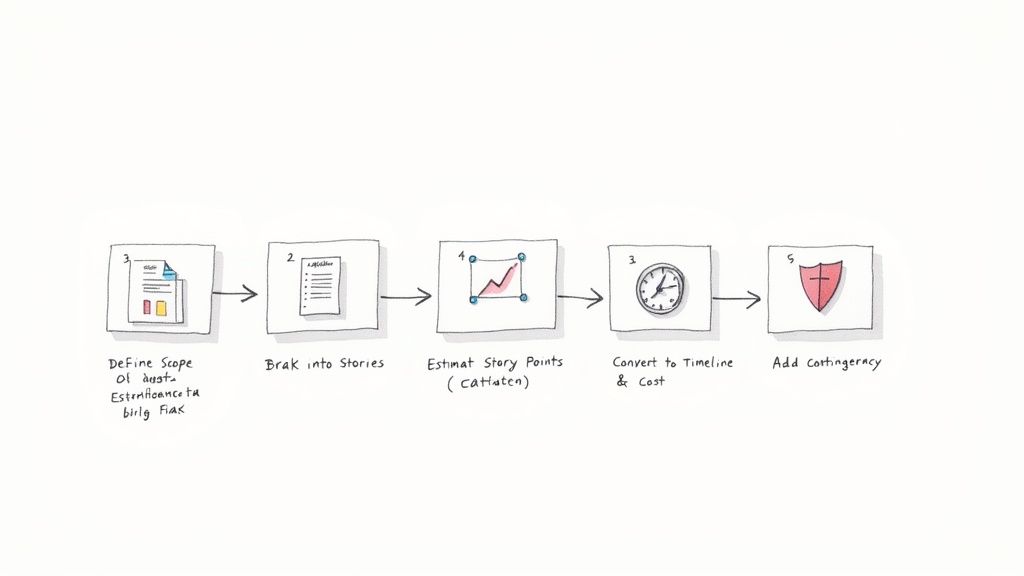
Step 1: Define and Document the Project Scope
Every good estimate starts with a crystal-clear understanding of the project scope. This is where you translate a big-picture vision into a concrete set of requirements. Any ambiguity here is a recipe for disaster, leading to the dreaded "scope creep" that blows budgets apart.
Your job is to document everything the software needs to do. This usually involves:
- User Stories: Describing features from a user's point of view. For instance, "As a customer, I want to reset my password via email so I can get back into my account."
- Functional Requirements: Outlining specific system actions, like processing payments or exporting data to a CSV file.
- Non-Functional Requirements: Defining how the system should be, covering things like performance (pages must load in under 2 seconds), security standards, and how it will scale with more users.
A well-documented scope becomes the project's single source of truth, making sure everyone—from the dev team to the CEO—is working from the same playbook.
Step 2: Break Down Features into Manageable Tasks
With the scope locked in, it's time to slice and dice. A massive feature like "Build User Authentication" is way too big and vague to estimate with any accuracy. You need to break it down into smaller, bite-sized tasks that the team can actually wrap their heads around.
For example, that "Build User Authentication" epic could be broken down into:
- Create the user registration form with input validation.
- Develop the secure login screen.
- Implement the "Forgot Password" workflow.
- Set up email verification for new accounts.
- Design the user profile management page.
See the difference? We went from a huge, abstract idea to a list of tangible jobs. Now your team can evaluate the effort for each specific task instead of just guessing at the whole thing. This level of detail is exactly what you need for an accurate estimate.
An estimate is not a promise carved in stone; it's a forecast based on the best information you have at a specific moment. The more you break down the work, the better your information becomes, and the more accurate your forecast will be.
Step 3: Apply an Estimation Model and Calculate Effort
This is where you start putting numbers to the work. Using a relative model like Story Points, your development team can work together to size up each task based on its complexity, effort, and any potential roadblocks. The key here is that it's relative—it’s not about guessing hours, but about comparing tasks to each other.
Once every task has a point value, you just add them up. Let's say the total comes out to 250 points for the entire project. That number now represents the total volume of work needed to deliver everything you've defined.
Step 4: Convert Effort into a Timeline and Cost
So, what do 250 points actually mean in terms of time and money? This is where your team's velocity comes in. Velocity is simply the average number of story points your team consistently completes in a single sprint (usually a two-week period).
If your team's average velocity is 25 points per sprint, the math is simple. A 250-point project will take roughly 10 sprints (250 / 25), or 20 weeks, to finish.
From there, calculating the cost is just a matter of multiplication:
- First, figure out your team's cost per sprint (including salaries, tools, and overhead).
- Then, multiply that cost by the total number of sprints.
If a sprint costs your company $20,000, a 10-sprint project will have an estimated development cost of $200,000. To really nail this part of the process, it helps to master project cost estimating for total budget confidence.
Step 5: Add a Smart Contingency Buffer
Let's be real: no project ever goes exactly to plan. Unexpected bugs pop up, technical challenges emerge, and requirements sometimes get misinterpreted. A contingency buffer is your professional acknowledgment of this reality. It's not "padding" the budget; it's a calculated safety net for the inevitable bumps in the road.
A healthy contingency buffer is typically between 15% and 25% of the total estimated cost. For our $200,000 project, a 20% buffer adds $40,000, bringing the final budgeted cost to $240,000. This one simple step makes your estimate far more realistic and resilient, setting the project up for success from day one.
How AI Is Reshaping Cost Estimation
For decades, software cost estimation has been more of an art than a science, heavily reliant on gut feelings and past experiences. That’s all changing. Artificial intelligence is now stepping in, transforming this subjective process into a far more precise, data-driven discipline.
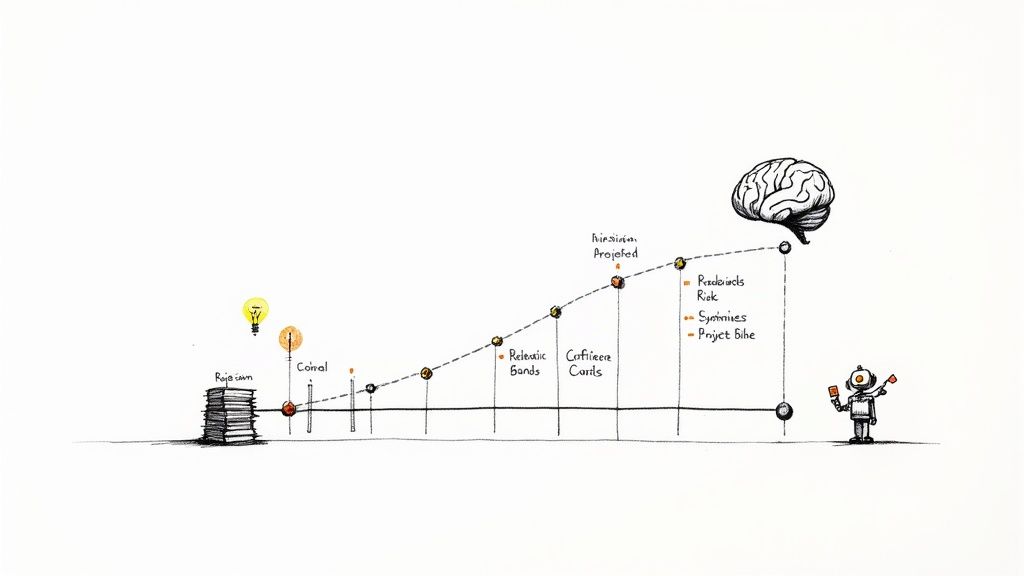
Instead of just leaning on human intuition, modern AI-powered platforms sift through mountains of historical project data. They learn from thousands of past projects—both the wins and the losses—to spot patterns in scope, complexity, and even team dynamics. The result? Predictions for timelines and budgets that are often startlingly accurate. This approach strips away the human biases that so often lead to wildly optimistic or just plain wrong initial estimates.
Predictive Analytics and Pinpointing Risk
One of the biggest game-changers AI brings to the table is predictive analytics. AI models can run thousands of project simulations in seconds, flagging potential risks long before they blow up your budget. For instance, an AI tool might warn you that integrating a particular third-party API has historically added a 20% delay to projects of a similar size.
Think of it as having a seasoned project manager who has seen every possible pitfall and can give you a heads-up. This kind of foresight lets teams proactively adjust their plans, allocate extra resources where they’re needed most, and build smarter contingency buffers.
Automation and Better Efficiency
AI’s impact isn’t just about making better guesses; it’s also about cutting down the actual work. AI-driven tools can automate tedious coding tasks, generate boilerplate code, and even suggest more efficient algorithms for developers to use. This directly cuts down on labor hours, which naturally lowers the overall project cost.
The numbers back this up. Between 2023 and 2025, AI’s role as a key driver of software cost changes more than doubled, jumping from 28.79% to 64.62%. As AI makes workflows smoother and helps teams deliver faster, it’s fundamentally changing the economics of building software. You can get more details on how AI is driving software development costs.
AI doesn't replace the need for skilled developers and project managers. Instead, it equips them with powerful tools to make smarter, data-backed decisions, turning uncertain forecasts into reliable financial plans.
Of course, there's an upfront cost to adopting these AI tools and getting teams up to speed. But the long-term payoff is undeniable. By bringing AI into the process, companies can budget more precisely, work more efficiently, and set their projects up for financial success right from the start.
Getting Your Project Estimates Right: A Few Best Practices
A solid software development estimate does more than just predict costs. It’s a forecast for your budget, sure, but it's also a powerful tool for getting everyone on the same page. Making the leap from a hopeful guess to a truly reliable estimate isn't magic; it's a disciplined process built on a few core principles. Think of these practices as the guardrails that keep your project on track and your budget in check.
The single best thing you can do for accuracy? Get the whole team involved in the estimation process. A project manager might see the big picture, but it’s the engineers, designers, and QA specialists who live and breathe the details. They’re the ones who will spot the hidden complexities and potential roadblocks that one person, looking from 30,000 feet, is bound to miss.
When the people who will actually build the software are part of estimating it, something powerful happens. The numbers become more realistic, and you get genuine buy-in from the start.
Re-Estimate Often as You Learn More
Let's be honest: your very first estimate is made when you know the least about the project. As you start building, your team uncovers new information, requirements get clearer, and the real technical hurdles come into focus. That's why you can't treat estimation as a one-and-done task. It has to be an ongoing conversation.
Revisiting your estimates at key milestones lets you course-correct based on what you've actually learned, not just what you assumed. This iterative rhythm keeps stakeholders in the loop and stops small miscalculations from snowballing into massive budget blowouts. You're simply swapping old assumptions for new facts.
A reliable estimate isn't a static number carved in stone at the start. It’s a living document that gets sharper and more accurate as project uncertainty gives way to real-world knowledge.
Be Crystal Clear About Assumptions and Risks
Every single estimate is built on a pile of assumptions. Which third-party APIs will we use? What kind of server load are we expecting? Writing these down alongside your numbers is non-negotiable. It gives everyone the context they need and spells out the "if-then" conditions of your forecast.
Just as important is calling out the risks. Being upfront about what could go wrong—and how that might hit the timeline or budget—helps stakeholders make smarter decisions. It builds a foundation of trust and turns estimation from a simple math problem into a strategic discussion about the project's health.
Look to the Past and Plan for the Unexpected
Your old projects are a treasure trove of data. Dig into them. How long did it take to build a similar feature last time? Using that historical data gives your new estimates a firm anchor in reality, pulling them away from the realm of pure guesswork.
Finally, always build in a buffer. Every project hits a snag—it’s just a matter of when. Scope creep, an unexpected bug, a team member getting sick. A contingency buffer, usually somewhere between 15% and 25%, isn't about padding the numbers; it’s a professional nod to the unknown. It’s the safety net that ensures a minor hiccup doesn’t derail your entire project. Honestly, this one simple step often separates the projects that succeed from the ones that don't.
Frequently Asked Questions
Even with the best planning in the world, a few questions always pop up when it comes to software development cost estimation. Let's tackle some of the most common ones that teams face when the rubber meets the road.
What Is a Safe Contingency Buffer for My Budget?
Think of a contingency buffer as your project's financial safety net. It’s not just extra padding; it's a smart way to prepare for the unknowns that inevitably crop up.
A good rule of thumb is to add 15% to 25% on top of your total estimated cost. For a straightforward project with well-defined requirements, 15% might be plenty. But if you're working with brand-new technology or there’s a lot of uncertainty, leaning closer to 25% is a much safer bet.
What Is the Difference Between an Estimate and a Quote?
Getting this wrong can lead to some seriously awkward conversations down the line. It's a critical distinction.
Here’s the simplest way to think about it:
- An Estimate is a professional guess. It’s a ballpark figure based on what’s known at the time, and it's expected to change as more details come to light.
- A Quote is a fixed price. It's a formal offer to complete a specific, agreed-upon scope of work for a set amount. Once you accept it, that price is locked in.
An estimate gives you a budget to plan around, while a quote gives you a fixed price to pay. Always clarify which one you are receiving from a development partner to ensure everyone's expectations are aligned.
How Can I Lower Costs Without Sacrificing Quality?
Trimming the budget doesn't have to mean you'll end up with a shoddy product. The trick is to be smart and prioritize what truly matters.
One of the most effective strategies is launching a Minimum Viable Product (MVP). Instead of building every feature you can dream of, you focus only on the absolute essentials needed to solve a core problem for your first users. This lets you get real-world feedback before you invest heavily in features people may not even want.
You can also look into using open-source tools and frameworks to avoid hefty licensing fees. For a deeper dive into this, our guide on the average cost to develop an app breaks down how different choices can really impact your final spend.
Why Do Final Costs Rarely Match the Initial Estimate?
It's simple, really: you know the least about a project right at the very beginning. That initial estimate is based on the best information available, but as the team gets their hands dirty, they always uncover complexities that nobody could have seen from the outset.
The biggest reason for the difference is almost always scope creep—when new features and ideas get added to the project without also adjusting the budget or timeline. Other common causes include hitting unexpected technical snags or finding out that an integration with a third-party service is far more complicated than it looked on paper. This is precisely why experienced teams re-estimate their work at key milestones.